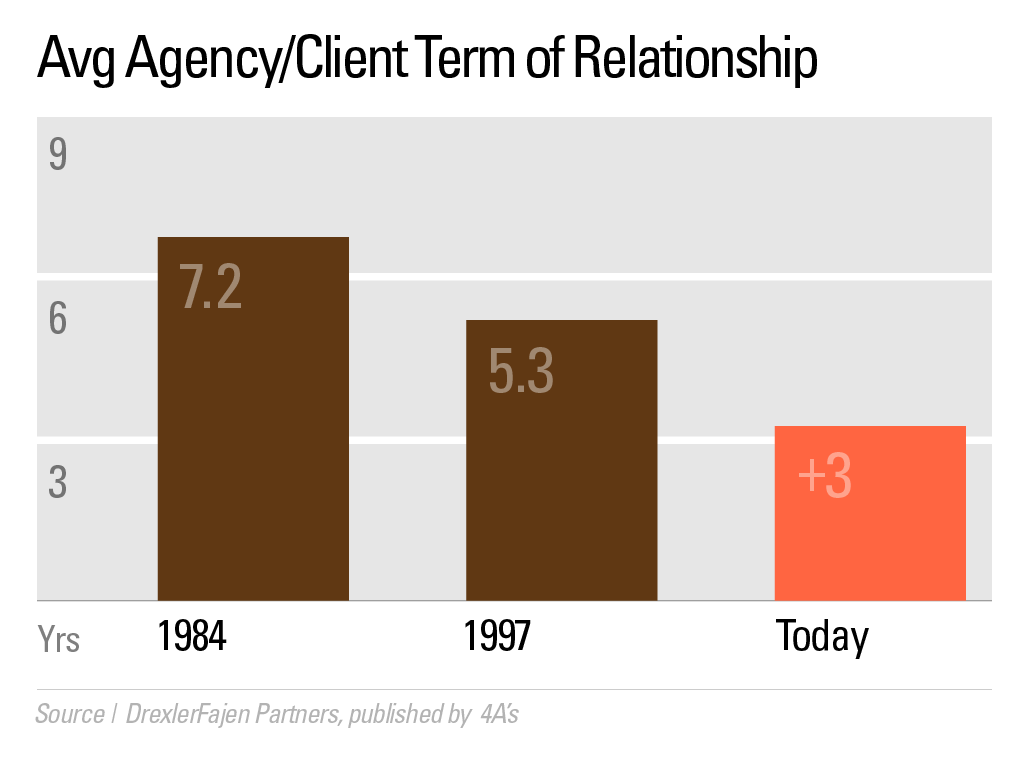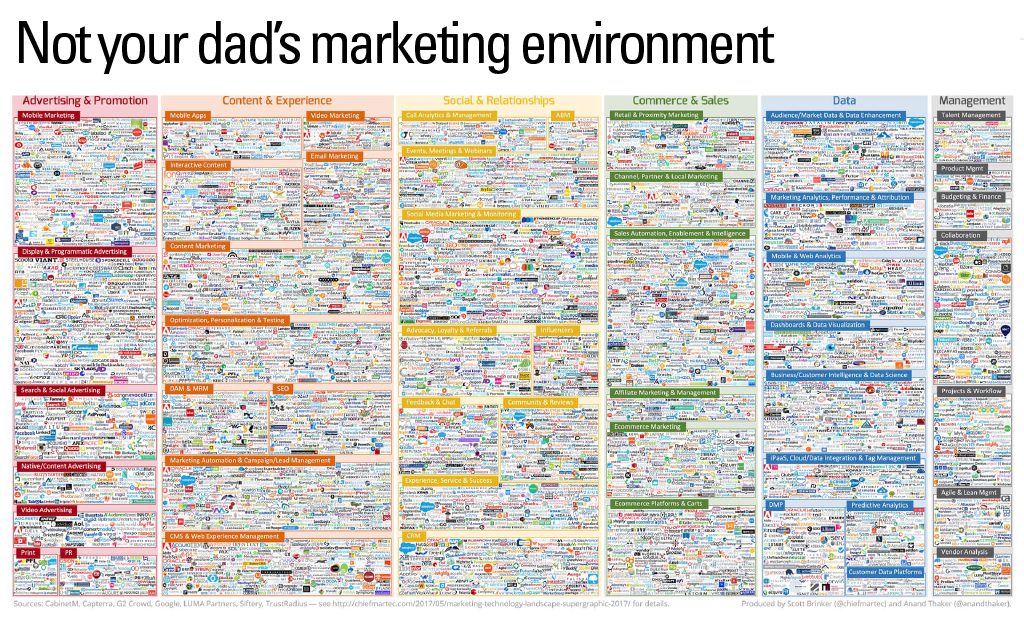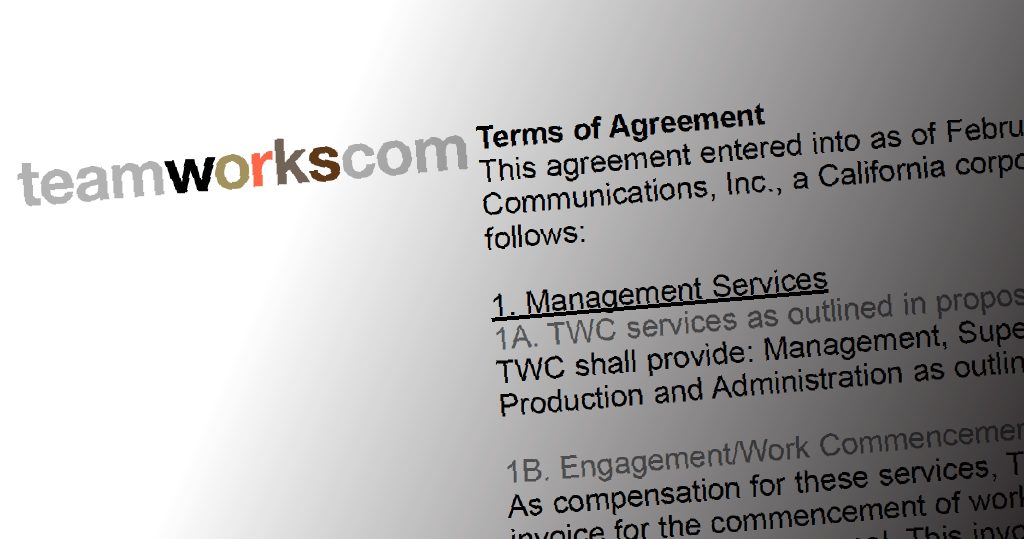A different beginning.
These days, success with online marketing is anything but simple or easy. That’s because this now required endeavor for any business is determined by a complex set of interconnected disciplines, technologies, and people.
The good old days when clients were happy to see an increase in brand awareness are so over. Agencies are now increasingly judged on the ROI they deliver—not just their creativity.
A disruptive trend.
To put this in perspective, in 1984, the average term of a client-agency relationship was 7.2 years. By 1997, that number declined by 25% to 5.3 years. And according to agency review and compensation specialists, DrexlerFajen Partners, as published by the 4A’s, the average client/agency relationship today has dropped to between 3-4 years.

Marketing has been transformed into a vast, complex and ever-changing environment of digital technologies, message segmentation platforms, and social networks of widely distributed user-generated content. As a result, few agencies can offer the entire spectrum of marketing services in a way that meets the individual needs of their clients.
Greater specialization of services along with the blending of functions such as advertising, PR and digital strategies has moved clients to consider or hire multiple resources. And when time-challenged clients attempt to corral a number of fragmented, competitive providers under one integrated marketing communications strategy, they usually struggle to do it well.

In this changing environment, both agencies and clients may be working with smaller teams. And with a commensurate increase in discomfort or stress, they are being tasked with delivering much more with far fewer resources.
In a volatile environment like this, gurus, pundits and experts across the web profess to have the silver bullet solution to achieve success with online marketing. They include:
- | Quality of the resources planning, managing + executing the services
- | Investment aligned with revenue goals
- | Campaign integration
- | Effective distribution
- | Alignment with sales
- | Creativity of solutions
- | MarTech platforms + infrastructure alignment
- | SEO
- | Offer + content quality
- | And more
While all of these attributes matter a lot, they overlook the one thing that matters the most to achieve long-term success with online marketing.
That’s a relationship.
That’s right. That fuzzy, elusive, ever-changing thing that’s the hardest to quantify, most difficult to develop and very challenging to effectively sustain.
The moving target of a valued client relationship.
It’s not an overstatement to claim that without a trusted, high-quality and transparent relationship with a customer—especially one that is purchasing online marketing services and expertise—a bad outcome is virtually guaranteed.
If you’re brave enough to be a provider of online marketing services—for even a short period of time—you, no doubt, have the first-person experience with what can cause a break up with a client. These include:
- | Your primary contact departs
- | A group, division or business unit is reorganized + people are realigned
- | Your customer’s organization gets acquired
- | Client revenue declines
- | Your budget gets a haircut
- | The organization decides to DIY
- | Your performance doesn’t measure up
- | An inconsequential event/issue escalates
- | Trust or credibility diminishes
- | A disparaging insider trash talks you
- | And many, many more
Navigating these minefields takes nimble skill and continuous effort. And for those with less experience, the result of a misstep can have serious consequences including:
- An uncooperative or unresponsive customer
- Proven processes get neglected or dismissed
- Credibility is compromised
- Distrust escalates
- Your customer doesn’t want to talk—they just send email
- Liability exposure increases
- Documented paper trails increase—for everything
- Revenue gets harder to collect
For those who have chosen to provide online marketing services and expertise, it’s not an option to pray for the best and hope that you’ll never have to face the hard reality of a client divorce. That’s because it’s not a question of IF it’s going to happen. It’s a question of WHEN.
There’s no better way to prepare for the inevitable than to have a specific, actionable plan to part ways with a customer BEFORE you’re in the middle of a messy divorce.
If it’s not in writing, there’s no CYA.
These days, a handshake or verbal agreement for anything—especially marketing services—is completely unacceptable. So you better ensure that you put everything that you’re going to do for your client in writing and in advance of doing any work, ever. Why?
Because it protects you and them and offers a transparent summary of what’s going to happen, who’s going to do it, how long it will take and what it will cost. Without this essential written agreement, signed and authorized by both parties (along with an engagement fee) you don’t have a client. You have absolutely nothing.

In addition, your proposal MUST include all the necessary specifics of what will happen if either party decides that it’s time to part ways. By stating your terms of disengagement, you underscore the legitimacy of your commitment and your intent to help your client succeed. You also disclose the financial impact of separation and what exposure both parties’ have in breaking up.
Guiding principles for this critical description of your relationship demand a fair and reasonable approach that is not one-sided or titled to either party’s favor.
It’s over. Now what?
Once you have delivered a formal notice of your intent to separate—or they decided to throw you over—you need to develop and share a detailed “transition plan” with your ex.
Like your original proposal of services, this plan needs to disclose and summarize what’s going to happen, who’s going to do what, how long it will take and what it will cost. Even if you’re initiating the break-up, you need to remind and disclose both party’s responsibilities to the original contract and its terms. No original contract? No bueno for you.
Specific actionable tasks
It’s really important that a transition plan breaks down and identifies a specific set of actionable tasks in sequence. This sets an expectation with your ex and provides guidance for you and your team to achieve identified elements that cannot be challenged or disputed.
Clear timeline
Your transition plan should also provide specifics on how long it will take to execute every tactical item of your plan. It will keep you and your former client on track. And it will mitigate the downside exposure that your separation becomes a drawn-out, financial train-wreck.
Once your soon-to-be-former client is officially notified of your intention to part ways, it makes sense to inform them that you will be diligent about executing your transition plan within the constraints of your resources at hand.
If it’s not obvious, you will have terminated the opportunity for any further or future revenue from your ex-client. Therefore, you need to focus your time and resources accordingly and execute the separation in the most efficient manner possible. Fairness and professionalism should be your guide. Charity or giveaways are to be avoided.
A roadmap to client separation and DIY.
Below is a detailed and specific action plan for the transition to a client managing their own website + online/content marketing.
The items in the 4-phase plan should be structured to conclude on specific dates. Leaving issues open-ended or vague is not a good idea —unless you want to deal with an ongoing headache and never stop hemorrhaging lost revenue.
Step 1 | New Client-Direct Hosting Account
Former client needs to:
- Open a hosting account with the hosting provider of their choice
- Set up monthly recurring payment
- Provide you with all of the host server side info so that you will be able to successfully execute the migration to their new hosting provider
- Should all be completed by a specific date
Step 2 | Move Live Site Content + Data to customer
Export, clone or replicate your customer’s site including:
- Content + CMS | Content Management System:
theme, framework, pages, posts, comments, images, html, css, php and free + licensed plugins for specific site functions - SQL database
for interconnection + management of all of these components/elements - Move site to the new customer account or confirm that they will execute this task for themselves
- Note | this cannot be completed until your former customer has enabled + paid for a new hosting account with a valid hosting provider
- Alert your customer via email by that their website has been moved to their host + it has been successfully competed
Deliver Backup + Data Files
Provide ex client with the following data and files:
- All site data including content + database
- Marketing Automation or CRM contact, lead + customer data
- Form conversions data
- Site subscriber data
Limit use of Licensed Tools/API’s
While making these moves can seem rather straightforward, you may have used subscription-based development tools and/or pro-class plugins that may have been licensed for use and integrated into the live website that you built or your former customer.
If you pay for a monthly usage of these tools, you’ll want to ensure that your former customer will not be able to receive the benefits of them at your expense. Frequently used tools can include:
- Theme Framework—for site code backbone
- WordPress Extensions—for custom page content or landing pages
- Other Extensions or plugins for front-end + mobile styling
- Form plugins—for submission notification + data capture
- Marketing Automation license code or API’s
- Tools for social sharing/analytics
- In-site subscriptions or pop-up alerts
- Other tools for image compression, anti-Spam Comments, shareable blog commenting + analytics
- And many more
If you grant your customer use of these licensed tools/plugins, you need to specify a specific time when you will disconnect them from your former customer’s website. After that date, if your ex-client refuses to purchase or subscribe to these tools in their own accounts, the functionality that they have become accustomed to—or have taken for granted—will no longer work.
Be specific and do not assume that they will want to understand the technical details. But leave no doubt about what will fail to work as it had before.
Step 3 | Marketing Automation/CRM Migration
If your former customer is a Marketing Automation | MA user and they have licensed an instance to use a SASS MA tool, like HubSpot, Marketo, InfusionSoft or SharpSpring, they will need to contact the MA provider directly to set up and enable their own Account.
This is not an insignificant exercise. Because virtually all of the credible MA providers have substantial on-boarding fees for new customers. Many online marketing agencies resell their MA licensing fees at a discount to their clients because they are able to spread the cost of the agency license over many accounts. If your former client wants to go solo, this is a barrier most small to mid-sized clients won’t be able to overcome.

MA/CRM Data Migration
If your former customer develops a direct relationship with an MA or CRM provider and enables their account, you can then draft instructions to your MA provider authorizing them to migrate your former customer’s data to their new instance
This should provide your former customer with:
- MA History + performance data
- MA forms on all landing pages
- MA emails attached to all content/campaigns
- CRM data
- User accounts
If there are issues, your former customer can troubleshoot any integration issues with the MA provider and their account.
You need to effectively dis-engage with the MA provider as they will now have a direct relationship with your former customer. They should help them your ex-client address any integration, data or use issues.
Step 4 | Live Site Hand-off to Client Host Account
Your client will need to redirect their domain registrar to point their domain to the new host IP address. They should notify you when the redirect is completed
Document everything + cc: them in email.
It is a best practice to inform and document the completion of each phase of your transition plan in clear and concise emails. The goal is to have a comprehensive archive of complying with the plan, and the actions in it. This effectively demonstrates your professional and consistent execution of the plan. Fail to do this well and you open your organization to unnecessary liability.
Execution of your transition plan must conclude your engagement with your former customer on a specific date. Delays to the transition plan schedule can result in additional resources/time that need to be accounted for.
Your transition plan should only include the services outlined. And if your former customer requests additional services to execute actions outside of the transition plan, they need to be accounted for and billed at your hourly rate.
We’re done, right?
You need to send formal, written notification that you have successfully completed your transition plan. This will release you from all the responsibilities of your former relationship on a specific date. This includes oversight, reporting, maintenance and integration of all content assets, technologies and services.
It’s also essential to provide a summary statement outlining all outstanding invoices and/or applicable credits to your former customer’s account. If you don’t keep your housekeeping in order, you could be surprised by a taxable liability you didn’t plan for.
Give thanks. Then move on.
Before you wave a final goodbye, it’s a good practice to share the positives of what you accomplished together with your former client. Thanking them for the opportunity to provide your contributions to their success recognizes what you brought to the relationship.
Relationships are anything but easy. Every email, online meeting, text message, call, presentation, or in-person visit creates an investment in the opportunity to build credibility, trust, and equity in a relationship.
Unfortunately, this often fuzzy, exceptionally fragile, and usually very expensive requirement for business and online marketing success can be altered or disappear in less than a Nano-second. The result could be unmet expectations, or worse, a relationship on the rocks. If you find yourself there, it might be better to resign ASAP rather than face the extremely painful reality of an inevitable break up.
Parting thoughts.
Online marketing services providers need to continually stay focused, over deliver and do exactly what they say they’re going to do. It doesn’t mean you can’t be authentic. But it also means that you don’t have to compromise or make excuses for doing the best that you can to make your client a success.
Good luck as you move ahead with your ongoing and future client relationships. You’re going to need it.
As president and creative director of TeamworksCom, Paul develops brand strategy, engineers content to express customer value and creates integrated online and content marketing solutions to help businesses succeed. Connect with Paul, send an Email, or just call 415.789.5830.
